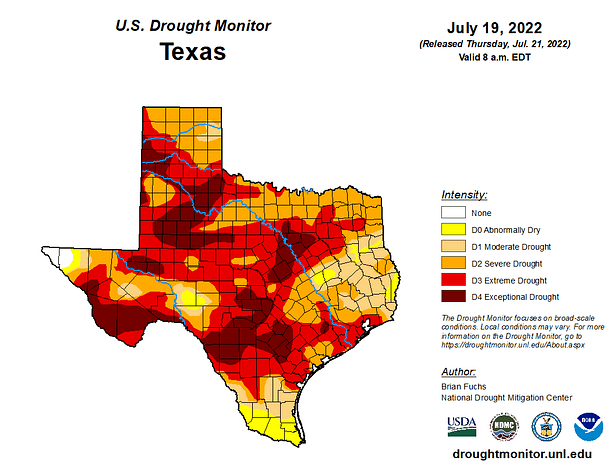Texas’ ongoing drought has begun to wreak havoc on the state’s agricultural sector.
As of late July, over 80% of the state is in the severe-to-worse drought category, according to the US Drought Monitor. The absence of beneficial rainfall, combined with excessively hot temperatures, has begun to affect Texas’ farms and ranches.
 Statewide reports already indicate that crop yields for all major Texas crops, including cotton, corn, sorghum and wheat, are lower this year compared to 2021. Crop yields in the Coastal Bend area are now 30% to 50% lower than normal. In Central Texas, the Lower Colorado River Authority has cut off water shipments to downstream farmers in order to preserve supplies within the Highland Lakes. And in West Texas, just as the absence of rainfall stymied crop growth, soaring energy costs are affecting farmers’ decisions to run groundwater pumps for crop irrigation.
Statewide reports already indicate that crop yields for all major Texas crops, including cotton, corn, sorghum and wheat, are lower this year compared to 2021. Crop yields in the Coastal Bend area are now 30% to 50% lower than normal. In Central Texas, the Lower Colorado River Authority has cut off water shipments to downstream farmers in order to preserve supplies within the Highland Lakes. And in West Texas, just as the absence of rainfall stymied crop growth, soaring energy costs are affecting farmers’ decisions to run groundwater pumps for crop irrigation.
Texas’ fabled cattle herd is being decimated.
Ranchers running out of working pastures and affordable feed have brought their cattle to the market in droves, resulting in a significant liquidation of the state’s cattle herd.
Already, some in the agricultural community have compared this year’s drought to that of 2011, which was Texas’ worst one-year drought of record.
According to data from the Texas AgriLife Extension Service, the 2011 drought inflicted $7.62 billion in economic losses on Texas’ agricultural sector, representing 43% of the average value of agricultural receipts over the previous four years. In particular, the 2011 drought wrought $3.23 billion in livestock, $2.2 billion in cotton and $736 million in corn losses. State wheat, sorghum and hay production were also severely affected.
While we now know the economic costs of the 2011 drought to Texas’ agricultural sector, a new report by Texas 2036 and the Baker Institute for Public Affairs at Rice University reveals what the costs of future droughts will be to the state’s economy if we don’t manage water supplies to meet growing demands.
The report assesses what the gross domestic product and job losses will be in Texas’ top five agricultural producing regions if the state endures another significant drought by year 2036. These regions include the Rio Grande Valley, east and northeast Texas, the Brazos River Valley, and the Llano Estacado in West Texas. Combined, these regions account for 54% of state agriculture GDP and 45% of agriculture-related jobs.
The report found that a severe drought in 2036 would have a profound economic impact on these five regions. Absent new water supplies or water management strategies, these areas could endure $3.5 billion in agricultural sector GDP losses and 62,000 agricultural-related jobs lost. As the report observes, these losses will have significant adverse effects within each region’s economy.
Of course, the statewide GDP and job losses in Texas’ agricultural sector will be much higher.
Barring the arrival of a hurricane or tropical storm system, immediate relief to current drought conditions does not appear imminent. Given the trends already observed this year, Texas’ agricultural sector is likely to endure significant economic losses due to our drought and hot weather. These losses will underscore the need for further investment in both water efficiency and water supply project development.
